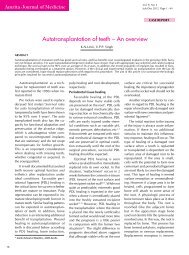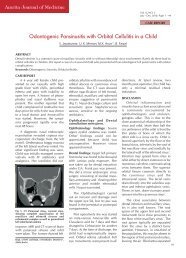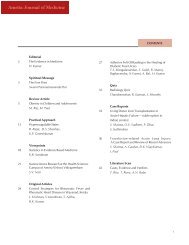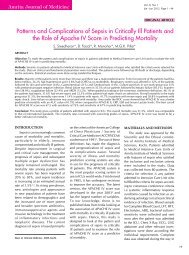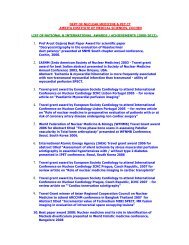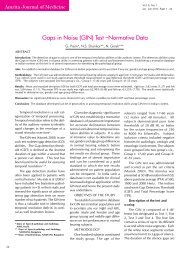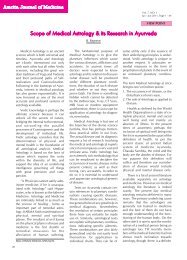Journal of Medicine Vol 4 - Amrita Institute of Medical Sciences and ...
Journal of Medicine Vol 4 - Amrita Institute of Medical Sciences and ...
Journal of Medicine Vol 4 - Amrita Institute of Medical Sciences and ...
You also want an ePaper? Increase the reach of your titles
YUMPU automatically turns print PDFs into web optimized ePapers that Google loves.
<strong>Amrita</strong> <strong>Journal</strong> <strong>of</strong> <strong>Medicine</strong><br />
Carcinoma <strong>of</strong> the Ovary<br />
patients with residual disease <strong>of</strong> less than 1 cm. It is<br />
shown that a possibly superior chemotherapeutic regimen<br />
containing taxanes cannot compensate for the tumor<br />
left behind after surgery. (19 JSO)<br />
The maximum goal <strong>of</strong> cytoreductive (debulking) surgery<br />
should be the complete removal <strong>of</strong> all visible disease<br />
<strong>and</strong> the minimum is to reduce the tumor to less than 1<br />
cm (optimal debulking). To meet this target one may <strong>of</strong>ten<br />
have to go for intestinal resections, rarely splenectomy,<br />
peritoneal excisions including diaphragmatic peritoneum<br />
<strong>and</strong> genito-urinary tract resections. Surgical procedures,<br />
which impair quality <strong>of</strong> life, for e.g. ostomies, should be<br />
avoided as far as possible. Precise <strong>and</strong> more expeditious<br />
removal <strong>of</strong> widespread peritoneal implants including diaphragmatic<br />
implants is facilitated by the use <strong>of</strong> Cavitron<br />
ultrasonic surgical aspirator (CUSA) <strong>and</strong> argon beam laser.<br />
Other modalities used are carbon dioxide laser <strong>and</strong><br />
loop electrosurgical excision procedures 5,6 . However in<br />
best h<strong>and</strong>s <strong>and</strong> best centers, many times the initial laparotomy<br />
turns out to be non therapeutic. The mortality<br />
<strong>and</strong> the morbidity due to haemorrhage in the presence <strong>of</strong><br />
friable growth may be overwhelming. In order to circumvent<br />
this problem <strong>and</strong> in view <strong>of</strong> the excellent response<br />
<strong>of</strong> tumor observed even after the futile initial laparotomy,<br />
the concept <strong>of</strong> interval laparotomy has come into practice.<br />
There is no r<strong>and</strong>omized trial data published in favour<br />
<strong>of</strong> interval cytoreduction. However several phase II <strong>and</strong><br />
retrospective data showed 3-year survival rate <strong>of</strong> 50%,<br />
which is comparable to optimal primary debulking. With<br />
neoadjuvant chemotherapy (NAC) 50% complete remission<br />
rate is reported <strong>and</strong> the complete / optimal resection<br />
is possible in 75% <strong>of</strong> cases. Our own data shows that<br />
the rate <strong>of</strong> optimal cytoreduction is 50% for primary surgery<br />
<strong>and</strong> 88.6% for patients who received NAC 7 . However<br />
it has to be clear that good reduction is not equivalent to<br />
initial small volume disease.<br />
For interval debulking also, just like primary surgery,<br />
one has to be prepared for any extent <strong>of</strong> surgery to completely<br />
remove the disease to microscopic level. So the<br />
minimum prerequisites for an ovarian cancer laparotomy<br />
are adequate infrastructure with adequate theatre facilities,<br />
dedicated team with adequate expertise <strong>and</strong> oncology<br />
concept. It has to be ascertained that no facility should<br />
<strong>of</strong>fer surgery for patients with ovarian cancer if adequate<br />
st<strong>and</strong>ards <strong>of</strong> care cannot be met with.<br />
Meticulous <strong>and</strong> systematic pre-operative evaluation<br />
has to be done to assess the operability <strong>and</strong> to avoid a<br />
non-therapeutic laparotomy.<br />
THE PREDICTORS OF SURGICAL<br />
OUTCOME ARE:<br />
1. Clinical evaluation: age above 50 years, gross ascites<br />
<strong>and</strong> fixed large pelvic masses are unfavourable<br />
clinical factors.<br />
2. Abdominal ultrasound: large volume ascites <strong>and</strong><br />
hydroureteronephrosis increase the inoperability rates.<br />
3. CT scan: Bristow 2000 selected 13 radiographic features<br />
along with performance status 8 . The important<br />
radiographic criteria considered are number <strong>of</strong> metastasis,<br />
peritoneal thickening, large ascites, large<br />
metastatic deposits on diaphram, suprarenal nodes,<br />
etc. Each parameter was assigned a numerical value.<br />
They reported that with a predictive index > 4, the<br />
specificity was 85% (inappropriate unexploration<br />
15%) <strong>and</strong> the sensitivity approached 100% (unnecessary<br />
exploration 0%). According to Dowdy, diffuse<br />
peritoneal thickening <strong>and</strong> large volume ascites independently<br />
predicted surgical outcome.<br />
4. Diagnostic laparoscopy:<br />
Inoperability criteria in advanced ovarian cancer:-<br />
Absolute<br />
a. Stage 1V disease or<br />
b. Metastasis <strong>of</strong> more than 1 cm at sites where optimal<br />
cytoreduction is not possible, e.g. at porta<br />
hepatis, around superior mesenteric artery, etc.<br />
Relative<br />
a. Uncountable (100) peritoneal metastases<br />
b. Estimated total metastatic load <strong>of</strong> >1000gm (both<br />
intra <strong>and</strong> extraperitoneal)<br />
c. Presence <strong>of</strong> more than 10gms peritoneal metastatic<br />
plaques<br />
d. Large volume ascites (5L)<br />
e. Those with performance status 2 or 3<br />
The time interval between diagnostic laparoscopy <strong>and</strong><br />
definitive surgery or chemotherapy should be as short as<br />
possible.<br />
ROLE OF RETROPERITONEAL LYMPH<br />
NODE DISSECTION (RPLND)<br />
Lymph nodal involvement in ovarian cancer is 20-<br />
40% (40 JSO) in apparently early disease to as high as<br />
70-80% in advanced disease. Early stages LND is recommended<br />
as a part <strong>of</strong> staging (some studies show improved<br />
survival also) <strong>and</strong> in advanced disease involved nodes<br />
are removed to attain R0 – R1 status.<br />
ROLE OF HYSTERECTOMY<br />
No studies so far tested the benefit <strong>of</strong> uninvolved<br />
uterus 9 . However, uterus should not be removed in instances<br />
<strong>of</strong> suboptimal tumor removal, since in the event<br />
<strong>of</strong> a subsequent recurrence, the tumor will directly invade<br />
the bladder.<br />
6



